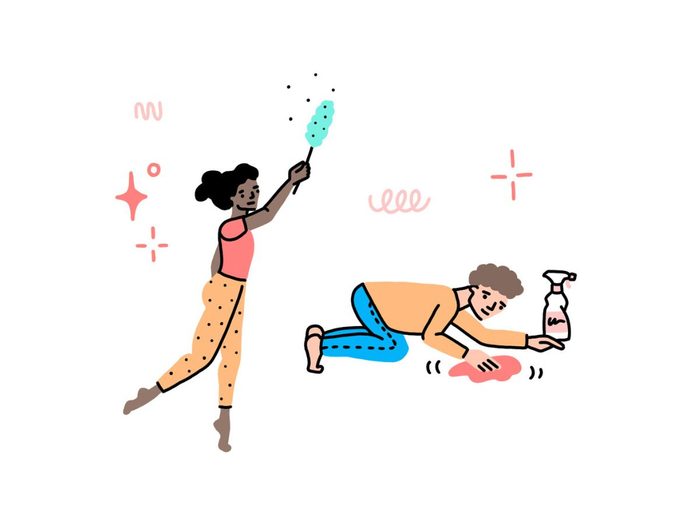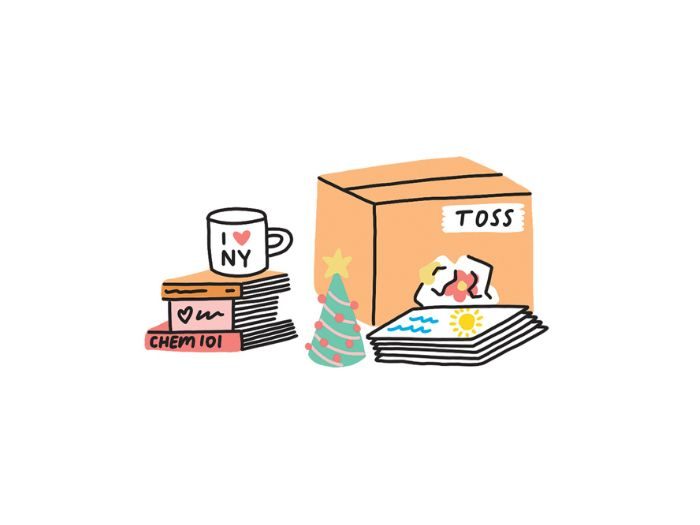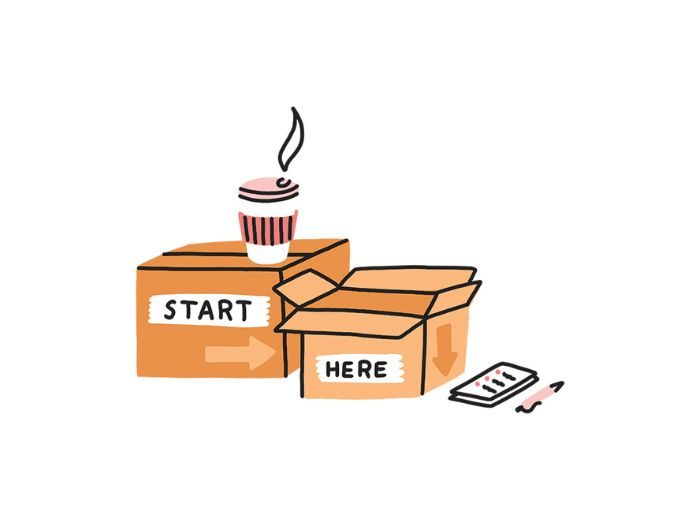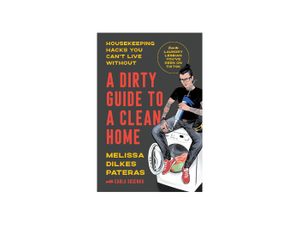6 Smart Ways to Have a Clutter-Free Home in 2024

Melissa Dilkes Pateras gained a huge following on TikTok for her funny tips on housecleaning and basic home repair. In this excerpt from her new book, A Dirty Guide to a Clean Home, she offers clear-eyed strategies for organizing even the most intimidatingly chaotic closets and junk drawers.
If I asked you to locate any item in your home, wouldn’t it be great if you could you find it with ease? Imagine having a home for all those pens you “didn’t steal” from work or being able to find a safety pin when you need one last minute. Imagine being able to find the spare batteries you’re sure you have somewhere instead of borrowing them from your remote or digging through the junk drawer. You know the one, we all have one: It’s where you have to push past the old takeout menus, past all the electronic cords you have no idea what they’re for but you can’t throw them away ’cause one day you might find out what mystery device they charge, past the spare piece of paper with someone’s number on it and you can’t remember who it is but you might need it someday, the free toothbrush you got from the dentist, a three year old ChapStick, to maybe, just maybe, find a battery, but it’s a AA when you needed a AAA. All that work and now you’ve disturbed the ecosystem of the drawer—so much that now you can’t get the damn thing closed.
Here’s the thing about that drawer: When you find a battery, does it always work? Or is it an old one that’s out of juice that for some reason you chucked back in there instead of the trash? There is a fine line between having an organizational system that works for you and having a messy dumpster fire of a drawer. Beware of that line. When it comes to tools to get organized, the list of things you absolutely need is pretty short: Garbage bags, storage, labels (optional), a gallon of determination, a shit-ton of focus and some time.
(Related: 30 Things You Should Clean in the Next 30 Days)

Start small and live large
I’ll tell you what we’re not going to do. We’re not going to organize your entire home all at once. That’s unrealistic, overwhelming and definitely not how I roll. We are going to start small. Our first goal is to pick a section: one room, one cupboard, one shelf, or even one tiny little drawer. I’ve said it before and I’ll say it again: start small. My aim is to set you up to succeed. As we’re just starting out on this organizational journey, I don’t want to overwhelm you. Once you conquer your first small goal, it will give you a sense of accomplishment that will prove to you that you can do this. It will also allow you to move at a pace that works for you. If I asked you to organize one drawer in your kitchen, that would seem like a doable task; but if I asked you to reorganize your entire kitchen, you’d probably get an overwhelming tightness in your chest. If we break it down, section by section, one drawer turns into two, then three, then a shelf, then a cupboard, and before you know it, the kitchen is done, no need for the overwhelming tight feeling in your chest. When setting a goal, you want to make it SMART! (That’s Specific, Measureable, Achievable, Realistic and Timebound.)
You’re a smart cookie, so make your goal SMART, too. Let’s break them down so they’re not so boring-presentationat-a-work-conference:
Specific: Pick one section of your home to organize. Start with a small drawer, a small shelf, that top cupboard, or perhaps, if you’re feeling adventurous, your entire closet. Whatever the section, be detailed and clear about what you want to accomplish and stick to it.
Measurable: Let’s stick with the drawer example. It’s a small space, so it’ll be easy to know when you’re finished. Once everything in it is easy to access and find, meaning no more shuffling the mess around just to get the damn thing closed, stay on track.
Achievable: Make sure the space you choose to organize is achievable. If the thought of cleaning out your closet all at once makes you feel overwhelmed, then pick something smaller, perhaps just your T-shirts. That’s more achievable. Make sure you are in the right mood to tackle the section you have picked. The more you achieve, the more motivation you’ll have to keep the ball rolling (and you know I love balls).
Realistic: Ask yourself, Do I have all the tools I need to complete this project? If it’s a drawer, maybe you need a drawer organizer; if it’s a closet, maybe you need shoe boxes; if it’s the dreaded Christmas decorations in the basement, maybe you need storage bins. Whatever the section, make sure you have the necessary tools needed on hand and ready to go before you start. You don’t want to have to stop halfway through to go to the store to get the items you need, run into Brenda while you’re there, end up having a 30-minute catch-up about how the kids are doing and then suddenly realize you need to get home and make dinner and no longer have time to finish the task at hand.
Timebound: This is the big one, and the real cause of our anxiety, because it’s something we never feel we have enough of. Make sure you set aside the time to start and finish the task. This means, be strict and give yourself a deadline. If anyone knows distraction it’s me, so if you only have an hour, perhaps today is not the day to do the entirety of your closet. You don’t want to have to stop halfway through because you have to pick your kid up from basketball practice and then come home and help your other kid with their science project that you just found out is due tomorrow. So perhaps an hour is best set aside for a drawer, or if you’re feeling courageous, perhaps two drawers. Make the time that fits the space you want to tackle, pop on some tunes, and get it done.
Abide by the keep, toss, donate, sell rule
The best approach to a real declutter-and-organize is to remove all the items from that space and divide them into four piles/categories: things to keep; things to throw away; things to donate; things to sell (yes, why not make a bit of cash while you’re at it?).
Now that we have our piles of things we want to keep and a nice clean drawer to put them back into, place those items back in a way that makes sense to you. For the things you want to throw away, put them in the trash never to be seen again. For the things you want to donate, place those in a bag and drive it to the donation bin now (remember to include that time as part of the project when you’re thinking about being Timebound, above). And for the things you want to sell, take some photos and post them on an online marketplace to sell right away. Don’t wait. The aim is for those three piles to leave your home as soon as possible, for two reasons: to remove the temptation of changing your mind and because you don’t want a bag of more clutter around the house when the goal is to declutter.
Goodbye, old charger cords that no longer serve you and hello, clean, organized drawer of AAA batteries you can find when you need them.
Taking everything out of one small section allows you to be critical of all the items and ruthless about what you really need and what you really don’t. If you don’t do that, you’ll just be shuffling things around in the space and not actually organizing anything. If you just push aside that pile of dress pants to the back of your closet instead of taking them out, you might not realize that one of them is a size 2 pleated black corduroy pant that you haven’t worn since the ’90s because a) they’re ugly and b) you haven’t been a size 2 since the ’90s. It’s as simple as that. But if it’s that simple, why haven’t you done it before? Well, simple doesn’t mean easy. If it was easy, you would have already done it. So, let’s talk about the process, the barriers and—most important—the solutions.
(Related: 18 Vinegar Cleaning Hacks That’ll Save You Money)
Get messy but not distracted
Yes, you heard it right. Organizing does involve getting a little messy first. Like I’ve said before, when you pick your space, whatever the space, no matter how big or how small, I want you to remove everything in that space and survey its contents. The taking-everything-out strategy works the same for an entire room as it does for a single drawer. So, pick your space, take everything out, get messy and assess what you’re working with, but most important, stay on task, because this is where our old friend distraction can pop by for a visit.
If you’re anything like me, it’s hard not to entertain distraction. The simple act of cleaning out your closet can sometimes turn into a movie-montage fashion show where you’re trying on old clothing and singing to the imaginary crowd attending your bedroom concert. We’re all guilty of it. We’ve all experienced the nostalgic feeling of rediscovering those forgotten photo albums or the worst culprit…old yearbooks. They instantly bring a smile to your face and trigger an old memory. REFRAIN!!! DON’T DO IT! PUT THEM DOWN!
It can happen fast—and not quicksand fast, but falling-througha-trapdoor fast. Little old innocent Memory Lane can send you on a detour down Where the F*ck Did the Day Go? Boulevard in a hurry. Mindless flipping through the pages of forgotten high school memories will quickly hurl you into an investigation abyss. Once you are into that box, it’s almost impossible to get out. Seeing Cheryl Farmer in that class photo will instantly get you wondering… whatever happened to Cheryl Farmer? Did she peak in high school? What she’s doing now? At this point it’s too late. You have already crossed into the danger zone. Next thing you know you’re on Facebook, typing in her name, hoping it’s still Farmer. Oh look! There she is. You find out she did marry Mark Murphy after all and it looks like they have two kids. The plot thickens…in 2014 she and Mark split up and she clearly invested in a quality, celebratory boob job. She loves selfies, wine, inspirational quotes and activewear. Wait…what were we doing?
I’ve gotten distracted like this many times while organizing, and to be honest sometimes it’s the fun part—but it’s also the part that could set you up to fail. So, if you know that you are prone to this type of distraction, allow time for it. If you’ve allotted time to specifically organize the yearbook drawer, then by all means, flip through the pages and reminisce, but keep your eye on the prize. You’ve set aside an hour to clean out and organize this space, so perhaps just take five minutes to flip through the pages of that yearbook, but then it’s book down and back to the task at hand. You can investigate Cheryl’s life path another time.
Now, you might think I’ve just taken the only joy out of organizing if you can’t spend hours reminiscing, but there are other ways to keep you entertained while still getting the job done. I work best when listening to music or a podcast, which is in the background enough that I can stay on task but enough of a diversion that I don’t feel so painfully bored. You know yourself. Pick something to have in the background that will keep you energized and motivated but not so enthralled that you want to stop what you’re doing. Think of this as a healthy distraction that will make the time fly by.

Get rid of the ones that no longer serve you
For some spaces this may be a few items here and there, and for other spaces you’ll be taking a trunk-load of bags to the donation bin. Have you ever felt like you have the weight of the world on your shoulders? Well, it’s not the world, it’s all of your stuff. If the idea of getting rid of things feels scary, that’s okay, you’re allowed to feel that way. But believe me, parting with things that no longer serve you can actually do the opposite: It can free you. Sounds simple right? But remember what I said, simple doesn’t mean easy.
Parting with things can feel like parting with a piece of yourself. Maybe that old blanket or teddy bear from your childhood is something you can’t part with. It’s okay to hold onto items that are truly sentimental, but does the trophy you won for a three-legged race at the fireman’s picnic in 1979 or the ticket stub from the Depeche Mode concert you went to in high school actually serve you in any way?
Have you ever filled a bag to drop off at a local donation bin and had a brief second, third, or even fourth thought of regret or uncertainty before you could let it go? You know you don’t need the stuff, you haven’t used it in years, and the space you removed it from looks so much better. But for some reason, you still have a moment of hesitation. You have a little conversation with yourself before you can let it go. Do I need it? Should I keep it just in case? Am I being wasteful or thoughtless? You are not alone.
If you are having a hard time letting go of an item, put it in plain sight for a while. Yes, I said in plain sight. Seeing it often will have you thinking about it more often. It will be easier to decide if it actually serves you. Hidden or tucked away will have you forgetting about it and allowing it to stay and take up space.
Out of sight, out of mind
In your sight, on your mind. Understanding that your memories are stored within you and not in your stuff may help a little. With that being said, a physical possession can trigger memories. Try taking a picture of an item before letting it go. If you have a collection of something, try hanging onto your favorites and letting go of the others. When you let go of things, you not only free up physical space, but you also free up visual busyness and space, which will in turn free up mental space. If you’re holding onto something simply because you fear you may need it in the future, think about how many times you have used it in the past year. The more unused and unloved possessions we hang onto, the more bound we feel to them and end up devoting more time and energy to maintaining and storing them.
I’m a vegetarian but I cook a turkey once a year, so I do need a roasting pan. I use it annually, it serves me and therefore there’s a good reason to keep it. If I never used it, it would have no utility and there would be no good reason to keep it. The key is determining what items actually serve you. If they don’t, let them go. Clutter begets more clutter.
But try to be honest with yourself. Do you need that T-shirt you got for participating in the charity walk-a-thon five years ago? These are not hypothetical questions; these are questions to ask yourself and try to answer honestly. I get wanting a lot of clothes, truly, but there are only seven days in a week.
Listen, nobody has more clothes than I do. I have had a Lululemon shirt in my closet for five years that I’ve never worn but refuse to get rid of. I hate the sleeves and I keep meaning to get it altered. It was $120, so it feels wasteful. But I have to be honest with myself: If it’s been five years, what are the chances this imagined alteration is ever going to happen? Is hanging onto the dress you splurged on but never wore somehow earning you your money back? Do you really want to torture yourself by keeping that pair of jeans just in case you lose weight? Do you really need all of those painting clothes for the one day a year you paint?
If the answer to any of those questions is no, get them outta there. Stop creating a function for things in order to justify keeping them. This is a convenient tactic for hanging onto shit you really don’t need. Less is more, almost always.
Questions to ask about every item you pick up:
• Do I love it?
• Do I use it?
• Does it enhance my life?
• Would I pass it on to a loved one?
• Do I have more of the same item?
• Would I buy it again today if it broke?
• Would my life be more difficult without it?
• Do I have somewhere adequate to store it?
• Is its utility worth my time to clean and maintain?
Stuff is just stuff. I’m a social worker, and earlier in my career I worked with kids who had experienced difficult home lives. Many of them had no possessions of their own. While out on excursions, a lot of them took flyers, business cards and pamphlets at every opportunity. The things they took were of no use to them, but they were theirs. Things can make you feel safe and secure, but as it accumulates you suddenly find yourself with too much. What started as safety and security flips to having the opposite effect: stress, anxiety being overwhelmed.

Think before you buy
Imagine for a moment that you’re done. Every inch of your house is decluttered and organized, and you can find things and live in your space with ease. Feels good, doesn’t it? Or does it? Maybe it also brings with it that small little worry of How am I going keep it this way?!? And that brings me to my little friend I like to call “keep-up.” The key to keeping up your organization is thinking before you buy.
Questions to ask yourself before you buy:
• Do I really need it?
• Why do I want it?
• Where am I going to put it when it’s not in use?
• How easy it is to clean and maintain?
• Do I already have one, and if so, do I really need another?
• Is this a replacement, and if so, am I getting rid of the old one?
You have to think about why you want what you want, and that’s a complicated question for most of us because shopping isn’t just about need. Shopping can be emotional, it can be therapeutic—but overshopping can also lead to clutter, which can lead to anxiety, which can lead to having a house you don’t feel comfortable in. A common example of overshopping is “It was on sale” buying. This is when you buy too much of an item that you use, or don’t use at all, just because it was on sale. Great that the spaghetti sauce was on sale and you want to pick up a few extras, but if you buy 47 of them, where the hell are you going to store it and will you ever be able to use it all before it expires? Sometimes we feel like we need every new gadget and tool—new things are fun!—but there is a big difference between need and want. When the line gets blurred, we can end up with a bunch of stuff that we thought we needed but don’t. When you’re considering buying or upgrading to a new gadget, again, mindfulness is key. For example, I have a Vitamix, but new blenders come out all the time.
So, I think to myself, Does this new blender do something so special that renders mine useless? If the answer is no, then I don’t buy a new one. I bought a Roomba because on TV, that thing glides through a house like a figure skater at the Olympics. Mine? It gets stuck on everything. It can’t get down the stairs. I bought it to make my life easier, and it doesn’t, so I hate it. And because I hate it, I never use it, and it’s just another appliance sitting in my garage in the Island of Misfit Toys. Most people don’t use gadgets that are complicated to clean. It’s great that I can whip up a smoothie in 30 seconds but when I have to take apart 500 pieces to wash and put back together, it doesn’t really seem worth it. If this is you, accept that about yourself.
There’s nothing wrong with it. It just means that appliances that require a lot of maintenance are not for you. My mission is to get you to enjoy the time you spend in your home doing the things you enjoy. Buying a new gadget might seem like it’ll help you enjoy your space, but before you purchase, follow the thought process through to the end. You know yourself better than anyone. If you really want something, get it! But pause first and consider how it fits into your life and your goal of feeling comfortable, organized and relaxed in your home.
When it comes to organizing, hopefully it feels a little lighter. I’ve taught you the how, the why and the keep-up—all you have to do now is go and do it. So remember what I said: one step at a time; you’re not going to move mountains overnight. Start small and stick with it. Be ruthless, be kind to yourself, but be realistic.

From the book, Dirty Guide to a Clean Home by Melissa Dilkes Pateras. Copyright 2023 by Melissa Dilkes Pateras. Reprinted with permission.
Next: A Guide to the Best House Plants, According to Science




